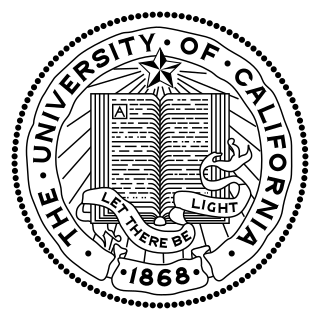
Arizona State University is a public research university in the Phoenix metropolitan area. Founded in 1885 by the 13th Arizona Territorial Legislature, ASU is one of the largest public universities by enrollment in the United States.

The University of California (UC) is a public land-grant research university system in the U.S. state of California. Headquartered in Oakland, the system is composed of its ten campuses at Berkeley, Davis, Irvine, Los Angeles, Merced, Riverside, San Diego, San Francisco, Santa Barbara, and Santa Cruz, along with numerous research centers and academic abroad centers. The system is the state's land-grant university. Major publications generally rank most UC campuses as being among the best universities in the world. In 1900, UC was one of the founders of the Association of American Universities and since the 1970s seven of its campuses, in addition to Berkeley, have been admitted to the association. Berkeley, Davis, Santa Cruz, Irvine, Los Angeles, Santa Barbara, and San Diego are considered Public Ivies, making California the state with the most universities in the nation to hold the title. UC campuses have large numbers of distinguished faculty in almost every academic discipline, with UC faculty and researchers having won 71 Nobel Prizes as of 2021.
Arizona State University at the West Campus is a public university in Phoenix, Arizona. It is one of five university campuses that compose Arizona State University (ASU). The West campus was established by the Arizona Legislature in 1984, and is located in northwest Phoenix, bordering the city of Glendale.

A research university or a research-intensive university is a university that is committed to research as a central part of its mission. They are the most important sites at which knowledge production occurs, along with "intergenerational knowledge transfer and the certification of new knowledge" through the awarding of doctoral degrees. They can be public or private, and often have well-known brand names.
Arizona State University Downtown Phoenix campus is a public research university in Phoenix, Arizona. It is one of five campuses of Arizona State University.
In the United States, higher education is an optional stage of formal learning following secondary education. It is also referred as post-secondary education, third-stage, third-level, or tertiary education. It covers stages 5 to 8 on the International ISCED 2011 scale. It is delivered at 4,360 Title IV degree-granting institutions, known as colleges or universities. These may be public or private universities, research universities, liberal arts colleges, community colleges, or for-profit colleges. US higher education is loosely regulated by the government and by several third-party organizations.

Little Big Horn College is a public tribal land-grant community college on the Crow Indian Reservation in Crow Agency, Montana. It has an open admissions policy and welcomes enrollment from any adult with a high school diploma or GED. The student body is composed of Crow Tribal members, members of American Indian Tribes from around the intermountain west, and non-Indian residents of the Big Horn County area.

Michael M. Crow is an American educator, science and technology scholar, and university design architect. He is the 16th and current president of Arizona State University, having succeeded Lattie F. Coor on July 1, 2002. During his tenure at ASU, he is credited with creating the New American University model.

The Ira A. Fulton Schools of Engineering is the engineering college of Arizona State University. The Fulton Schools offers 25 undergraduate and 48 graduate degree programs in all major engineering disciplines, construction and computer science. In 2023 the Fulton Schools became the first university in the nation to offer a bachelor's degree, master's degree and doctoral degree in manufacturing engineering.

Thunderbird School of Global Management is a business school of Arizona State University, a public research university in the Phoenix metropolitan area. It was founded in 1946 as an independent, private institution and acquired by Arizona State University in 2014. The school moved to ASU's Downtown Phoenix campus in 2018. The campus built a new $75 million building for the school in 2021.
Thomas Joseph Kane is an American education economist who currently holds the position of Walter H. Gale Professor of Education and Economics at the Harvard Graduate School of Education. He has performed research on education policy, labour economics and econometrics. During Bill Clinton's first term as U.S. President, Kane served on the Council of Economic Advisers.

The history of Arizona State University began March 12, 1885 with the founding of the establishment originally named the Territorial Normal School at Tempe. The school was founded after John Samuel Armstrong first introduced House Bill 164, “An Act to Establish a Normal School in the Territory of Arizona” to the 13th Legislative Assembly of the Arizona Territory. Instruction was instituted on February 8, 1886, under the supervision of Principal Hiram Bradford Farmer. Land for the school was donated by Tempe residents George and Martha Wilson, allowing 33 students to meet in a single room.
The Mary Lou Fulton Institute and Graduate School of Education at Arizona State University was established in 1954. It disestablished in 2010 by Provost Elizabeth Capaldi amidst strong objections from faculty, students, and relevant professional organizations. FIGSE is sometimes confused with ASU's Mary Lou Fulton Teachers College, which was renamed from the regional teaching-intensive West campus College of Teacher Education and Leadership (CTEL) at the same time the historic FIGSE was disestablished.
Theresa Ann Cameron was the first African-American woman to be awarded tenure in the College of Design at Arizona State University, in 2000.

R.F. “Rick” Shangraw Jr. was named president of Cintana Education on May 1, 2020. Previously, he served as chief executive officer of ASU Enterprise Partners from 2016 to 2019. He was chief executive officer of the ASU Foundation for A New American University from 2011 to July 1, 2017, after being appointed to the position by the Arizona State University Foundation board of directors on Oct. 31, 2011 succeeding Johnnie Ray. Previously, Shangraw worked in both the private and public sectors after beginning his career as an assistant professor at Syracuse University.

Harry Kenneth Newburn was an American educator. He served as the president of various universities during the mid-20th century.

Ray Anderson is the athletic director at Arizona State University since January 2014. He graduated from Stanford University, where he lettered in football and baseball, and Harvard Law School.










